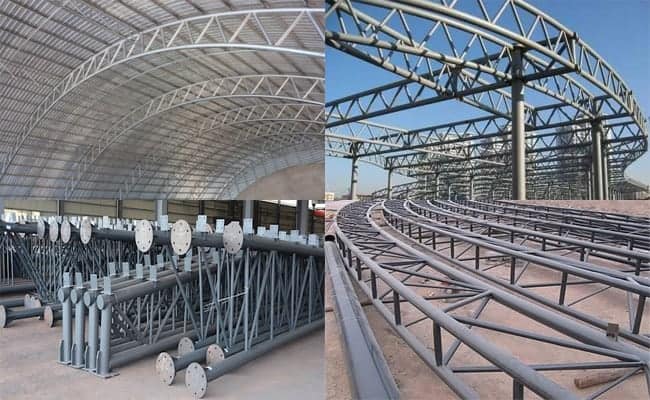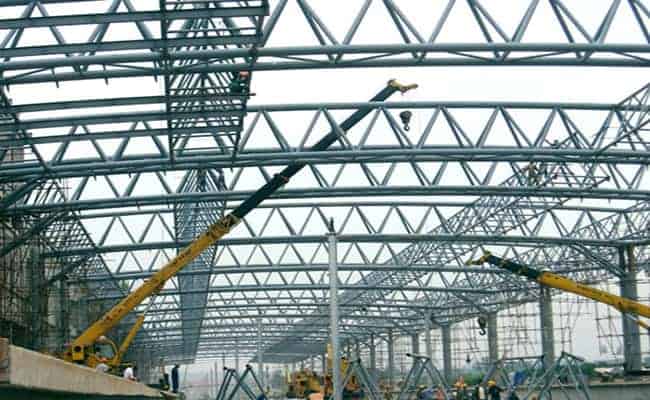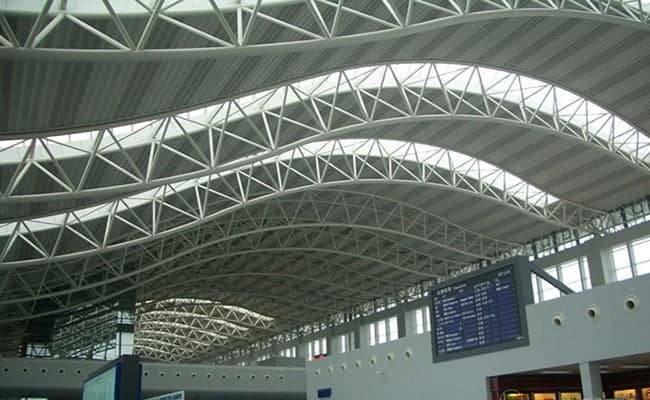Steel Tube Truss Introduction Large-span Structures
Home » Steel Building » Steel Tube Truss Introduction: Large-span Structures
In recent years, with the continuous growth of China’s steel production, steel structures have accounted for an increasing proportion of buildings due to their advantages, and steel tube truss structures have also made breakthroughs. The most significant advantage of the steel tube truss is that it can perfectly combine people’s functional, sensory, and economic benefit requirements for the building.
The tube truss structure has been widely used in public buildings, such as various stadiums, airports, train stations, exhibition halls, etc., due to its beautiful appearance, easy production and installation, good structural stability, high roof stiffness, and sound economic effects.

steel tube truss
Table of Contents
2.Characteristics of steel tube trusses:
2.1.Applications of steel tube trusses:
2.2.Classification of steel tube trusses:
2.2.1. Fixed tube truss:
2.2.2. Folding tube truss:
2.2.3. Butterfly tube truss:
2.2.4. Ball joint tube truss:
2.2.5. Triangular tube truss:
2.2.6. Trapezoidal tube truss:
2.2.7. Polygonal tube truss:
2.2.8. Open-web tube truss:
3.Composition of steel tube trusses
4.Advantages and disadvantages of steel tube trusses:
4.1.Advantages of tube truss structure:
4.2.There are also disadvantages to tube trusses,
What is a steel tube truss:
Characteristics of steel tube trusses:
Its stability is the same in all directions, saving material usage. The steel tube truss structure is developed based on the grid structure. Compared with the grid structure, it has unique advantages and practicability, and the steel used is also more economical.
Compared with H-shaped steel and I-shaped steel trusses, the cross-section materials of the pipe truss structure are more evenly distributed around the neutral axis. Hence, the section has good compression and bending torsional load-bearing capacity and greater stiffness.
The tube truss structure has good overall performance, high torsional stiffness, and a beautiful appearance. Making, installing, turning, and lifting are relatively straightforward.
The steel tube roof truss is made of cold-formed, thin-walled steel and has a light structure, good stiffness, and steel-saving characteristics. It can fully exploit Material strength and other advantages, especially in the pressure rod and support system controlled by the slenderness ratio. It is more economical.
The buildings currently using this structure are public buildings. The structure has a beautiful appearance (it can be built into a flat plate shape, round arch shape, or arbitrary curve shape), easy production and installation, good structural stability, high roof stiffness, and sound economic effect.

steel tube truss
Applications of steel tube trusses:
In most cases, the rods in the truss are only subject to axial tension or pressure, and the stress is evenly distributed throughout the cross-section, so the material can easily play a role.
These characteristics make the truss structure economical in materials and low in weight. It is easy to form various shapes to adapt to different uses. For example, it can be made into supported trusses, arches, frames, and towers.
Therefore, truss structures are today used in many large-scale venues, such as convention and exhibition centers, stadiums, and public buildings.

tube truss structure
Classification of steel tube trusses:
1. Fixed tube truss:
2. Folding tube truss:
3. Butterfly tube truss:
4. Ball joint tube truss:
5. Triangular tube truss:
Triangular trusses are primarily used in roof trusses with tile roofs due to the significant difference in the internal forces of the chords and unreasonable material consumption.
6. Trapezoidal tube truss:
If the upper and lower chords of the trapezoidal truss are parallel, it is a parallel chord truss. The stress of the rods is slightly worse than that of the trapezoidal truss, but the types of web rods are significantly reduced, and they are primarily used in bridges and trestles.
7. Polygonal tube truss:
Under the action of uniform load, the shape of the truss is similar to the bending moment pattern of a supported beam, so the upper and lower chord axial forces are evenly distributed, the web rod axial force is small, and the material consumption is the least. It is a commonly used truss form in engineering.
8. Open-web tube truss:
The axial force distribution of toolbox members is similar to that of polygonal trusses, but the bending moment value of the member end changes significantly under asymmetric load. The advantage is that there are fewer rods intersecting at the nodes, and construction and manufacturing are convenient.
Composition of steel tube trusses
The tube truss structure generally comprises main trusses, secondary trusses, ties, and supports.
Advantages and disadvantages of steel tube trusses:
Advantages of tube truss structure:
The most important thing among them should be that the pipe truss structure has a beautiful appearance, which makes it unique in shape and is loved by people. In addition, the tube truss structure has good overall performance, a large structural span, and high torsional stiffness.
Cold-formed thin-walled steel has the advantages of high stiffness, less steel consumption, and a light structure when steel pipe roof trusses are made. At the same time, if it is used in a pressure rod and support system with a controlled slenderness ratio, the economic benefits will be better. In constructing round arches and arbitrary curved shapes, there are apparent advantages over grid structures when the stability is the same and less steel is used, thus reducing the cost.
There are also disadvantages to tube trusses,
Although the trusses’ performance is stable after being integrated into a whole, the building space’s lateral stiffness is slight, and supports are generally necessary to improve the stiffness of the space.
- Pre:None
- Next:Steel Tube Truss Introduction 2024/4/30
